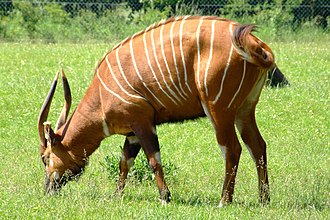
A Bongo antelope
This antelope is split into two subspecies:
- The Eastern or mountain Bongo- this is restricted to some mountain regions in central Kenya. It is classed as critically endangered in the wild – there are more in captivity than in the wild. It should be noted, that they breed readily in captivity, so while they may disappear from the wild, we will be able to return them to the wild at some point in the future. In 2013 it was estimated that there was only 100 of the animal left in the wild, and this has been caused by poaching and logging. As these things have not stopped, it may well push them to extinction.
- The Western or lowland Bongo – this is considered near threatened
There have been two other subspecies suggested from western and central Africa, but taxonomic clarification has not been reached.
Generally, males live alone, while females live in small herds with their young of up to 8.
They are mostly nocturnal or crepuscular (active in the early and late day). Generally timid and easily startled, they usually stay in think forest, which may be why few Europeans had seen one before 1960. They are found in kenya, along with these west African countries: Cameroon, Central African republic, Republic of the Congo, Democratic Republic of the Congo, Ivory Coast, Equatorial Guinea, Gabon, Ghana, Guinea, Liberia, Sierra Leone and South Sudan.
They prefer to live in areas of forest that are patchy, and as a result, do well where forest elephants live as well. In theory, they would also do well in areas which have been selectively logged, but this does not seem to happen at all.
As browsers, they eat a wide variety of leaves shrubs fruits barks and various other things that they can find.
Historically, weird superstitions protected the Bongo, as local people believed that eating their meat would cause something like epileptic seizures, unfortunately this superstition is being left behind, which may put further pressure on the species.
Bongo drums are a well known instrument in Africa. Indeed, I have one that my father brought back from a trip many years ago. Contrary to popular opinion, these are not made from Bongo skin, and despite much research there is little evidence that they ever were. They are generally made from cow or goat hide. While they may have been made from Bongo skin a great deal in the past, there is little evidence of population crash that might come with using the skin for a popular instrumept
Conservation status: looking at the land, and making sensible estimates on density, we get an estimate of around 28,000 individuals, however as only around 60% of this is protected, the number is expected to be lower, and is estimated to potentially be in the low 10s of thousands.
Bongo drums are a well known instrument in Africa. Indeed, I have one that my father brought back from a trip many years ago. Contrary to popular opinion, these are not made from Bongo skin, and despite much research there is little evidence that they ever were. They are generally made from cow or goat hide. While they may have been made from Bongo skin a great deal in the past, there is little evidence of population crash that might come with using the skin for a popular instrumept
Conservation status: looking at the land, and making sensible estimates on density, we get an estimate of around 28,000 individuals, however as only around 60% of this is protected, the number is expected to be lower, and is estimated to potentially be in the low 10s of thousands.
[smart_post_show id="15012"]











